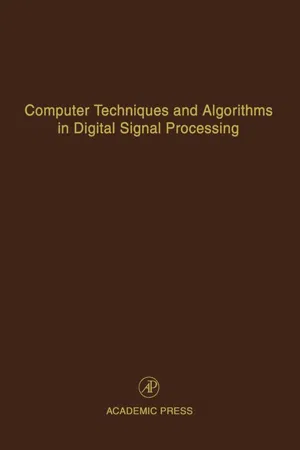
This is a test
- 411 pages
- English
- ePUB (mobile friendly)
- Available on iOS & Android
eBook - ePub
Book details
Book preview
Table of contents
Citations
About This Book
Covers advances in the field of computer techniques and algorithms in digital signal processing.
Frequently asked questions
At the moment all of our mobile-responsive ePub books are available to download via the app. Most of our PDFs are also available to download and we're working on making the final remaining ones downloadable now. Learn more here.
Both plans give you full access to the library and all of Perlego’s features. The only differences are the price and subscription period: With the annual plan you’ll save around 30% compared to 12 months on the monthly plan.
We are an online textbook subscription service, where you can get access to an entire online library for less than the price of a single book per month. With over 1 million books across 1000+ topics, we’ve got you covered! Learn more here.
Look out for the read-aloud symbol on your next book to see if you can listen to it. The read-aloud tool reads text aloud for you, highlighting the text as it is being read. You can pause it, speed it up and slow it down. Learn more here.
Yes, you can access Computer Techniques and Algorithms in Digital Signal Processing by in PDF and/or ePUB format, as well as other popular books in Technology & Engineering & Microelectronics. We have over one million books available in our catalogue for you to explore.
Information
Blind Adaptive MAP Symbol Detection and a TDMA Digital Mobile Radio Application
K. Giridhar†,†; John J. Shynk‡; Ronald A. Iltis‡ † Department of Electrical Engineering Indian Institute of Technology Madras 600036, India
‡ Department of Electrical and Computer Engineering University of California Santa Barbara, CA 93106
† K. Giridhar was with the Department of Electrical and Computer Engineering, University of California, Santa Barbara, CA 93106.
‡ Department of Electrical and Computer Engineering University of California Santa Barbara, CA 93106
† K. Giridhar was with the Department of Electrical and Computer Engineering, University of California, Santa Barbara, CA 93106.
1 Introduction
The transfer of information through a communication medium or channel invariably results in many kinds of distortion to the transmitted signal. Among the sources of distortion commonly encountered are intersymbol interference (ISI) due to the finite coherence bandwidth, fading due to the finite coherence time, and additive noise due to thermal energy and measurement errors.1 Such a channel can be modeled as a linear, finite impulse response (FIR) filter with time-varying channel coefficients, plus an additive noise component [1]. Throughout this article, we will assume that the additive noise is white and uncorrelated with the information sequence, and has a Gaussian probability density function (p.d.f.).
When the length of the impulse response is reasonably short and the channel coefficients are known or can be estimated, the principle of maximum likelihood sequence estimation (MLSE) [2] can be employed to decode the data sequence. Otherwise, channel equalization algorithms must be employed at the receiver prior to decoding the data. Adaptive channel equalization has been an active area of research for the last 25-30 years, and has produced a variety of algorithms. All such algorithms can be class...
Table of contents
- Cover image
- Title page
- Table of Contents
- Copyright page
- Contributors
- Preface
- Frequency Estimation and the QD Method
- Roundoff Noise in Floating Point Digital Filters
- Higher Order Statistics for Chaotic Signal Analysis
- Two-Dimensional Transforms Using Number Theoretic Techniques
- Fixed Point Roundoff Effects in Frequency Sampling Filters
- Cyclic and High-Order Sensor Array Processing
- Two-Stage Habituation Based Neural Networks for Dynamic Signal Classification
- Blind Adaptive MAP Symbol Detection and a TDMA Digital Mobile Radio Application
- Index